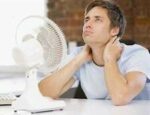 How to Stay Cool Even When You Have to Cover Up
How to Stay Cool Even When You Have to Cover Up
1. Start with moisture-wicking underwear. Uniqlo has several styles for both men and women and are available in-store and online.
2. Use natural-fiber outerwear. Try lightweight linens, pure cottons, and silk, as opposed to thicker textiles that trap more heat. Long sleeves and balloon sleeves allow air flow.
3. For added sun protection, wear UPF clothing. Tightly woven dark denim is one of the only natural-fiber fabrics that will block out almost all UV rays, but it’s heavy. Instead, lightweight synthetic clothing with a UPF (ultraviolet protection factor) rating creates a physical and/or chemical barrier to protect from the sun. To earn the Skin Cancer Foundation’s Seal of Recommendation, the clothing must be rated at least UPF 30, as explained in buying guide to UPF clothing.
 4. Pick the right head covering. A wide-brimmed hat is a great choice, and the more coverage, the better. Opaque tops and mesh sides aid airflow, although the mesh won’t protect against the sun’s rays. In The Best Sun Hat for Hikers, Wirecutter recommends the Columbia Bora Bora II Booney. We also like the certified UPF 50+ bucket hats from Barrière. If those styles doesn’t suit you, it’s not a dealbreaker—any hat is better than no hat.
4. Pick the right head covering. A wide-brimmed hat is a great choice, and the more coverage, the better. Opaque tops and mesh sides aid airflow, although the mesh won’t protect against the sun’s rays. In The Best Sun Hat for Hikers, Wirecutter recommends the Columbia Bora Bora II Booney. We also like the certified UPF 50+ bucket hats from Barrière. If those styles doesn’t suit you, it’s not a dealbreaker—any hat is better than no hat.
Also, be sure to slather all exposed skin with sunscreen, and use lip balm with SPF, like Supergoop Play Lip Balm SPF 30 with Acai. While you’re at it, toss on a comfortable pair of sunglasses so you’re not squinting. Those who wear a head covering like a hijab for religious reasons can choose a thinner scarf of a size and shape that can be single-layered, so you’re not doubling up on fabric.
5. Go swimming! There is a range of rashguards and bathing suits with sleeves to protect you in the water.

 6. Adjust your schedule. This may seem obvious, but there’s a reason the siesta was invented and farmers start work at the crack of dawn. Don’t go out in the heat of midday if you can avoid it.
6. Adjust your schedule. This may seem obvious, but there’s a reason the siesta was invented and farmers start work at the crack of dawn. Don’t go out in the heat of midday if you can avoid it.

7. Carry ice. Grab an ice cube when you leave the house and carry it on the way to the subway or the car. Freeze a bottle filled mostly with water the night before and then add some water on your way out the door. If you’re at home, dousing with cold water can also work wonders.
8. Place a cooling cloth on your neck. Dermatologist Sandra Johnson recommends applying a cooling cloth (or some ice) to your pulse points—wrists, neck/chest, or scalp—to cool down quickly. Storing two Frogg Toggs Chilly Pads in the fridge means you can use one and always have a second cool one at the ready.
9. Eat electrolyte-rich foods and drink water. Electrolytes are important to help keep you hydrated. Drink some water and have a little bit of umeboshi pickled plum, dried apricots, sunflower seeds, or pickle juice. Sports drinks tend to contain electrolytes, but many are also packed with sugar, which might not be ideal when you’re not actually exercising.
 10. Point a fan at your face. There are many portable and rechargeable fans to take along. And if you have the opportunity to duck into some A/C, do it. Even just a few minutes will help your body reset.
10. Point a fan at your face. There are many portable and rechargeable fans to take along. And if you have the opportunity to duck into some A/C, do it. Even just a few minutes will help your body reset.

Leave a Reply